- Home
- Zadie Smith
Feel Free: Essays Page 37
Feel Free: Essays Read online
Page 37
The only sublime shot was taken in Carcassonne (his choice), where he quite uncharacteristically demanded a car stop so he could walk back a few yards to the edge of a sheer drop that gave on to a view of a valley. Here he took a magnificent panorama, of hills and dales and forests and fields, and a little thread of blue running through it all. He never sent me that one, but I found several copies of it among his things after he died, as if he didn’t want me to know that the gardens he liked best were the wild ones.
THE SHADOW OF IDEAS
Se non è vero, è molto ben trovato
—Giordano Bruno
Piazza della Madonna dei Monti. There the morning sun gave us preferential treatment, casting the church and half the fountain into shadow, striking us instead at our usual table. I have my integrale, you have your spremuta, the dog is leaping at the waiters, and I am very proud of this little clutch of italicized Italian words. I am reading La Repubblica, very slowly, with a dictionary, but very proud. Sometimes people stop and speak to us in this Italian square, using the tu form, because we are young or youngish, or known to them or both. We live in Rome but I am a tourist. I never stop being one, particularly in the squares. I remained a tourist even in that little square, the one I burned down. Which fire was at the beginning, though in memory it comes at the end, and this is inconvenient, structurally. But my memories of our Italian squares are non-sequential, they jump from here to there, ignoring chronology. They are filed according to a variety of intimate systems—one of which involves the differing intensities of light—and so there is nothing to be done: we begin in Piazza della Madonna dei Monti, east of the river, not far from the Colosseum. You are reading the financial pages, like a local, whereas I am wondering about Vivaldi, like a tourist. I am aware that a performance of the Four Seasons is to happen in a basilica somewhere, at five thirty each weekday afternoon and twice on Saturday; I hate that I should know about it, but I do. Even if I don’t pick up the soggy flyer, stained by coffee rings and sprinkled with tobacco shreds, I register the invitation, knowing that it’s meant for the likes of me, for the ordinary tourist, although I am quick to agree with you when you say, “No fucking way, those things are awful. Plus Vivaldi is awful.” You bent down to pour a little Pellegrino on the dog’s panting face. The short waiter approached, the one without any beauty, though he was furbo, he watched everybody; we always left a euro to stay on his good side. He approached and the dog leaped up. I yanked her lead and pinned her stupid head between my ankles. In England this would be considered the right thing to do, but in that Italian square dogs were beloved and free to wander about by themselves, their leads trailing behind them, while their owners had coffee or bought a dress or whatever. The waiter looked with great sympathy at the dog; the dog had stopped being a tourist some time ago, now everybody pitied her for being stuck with us. He cleared the cups as we looked down at the table in silence. Once he had gone we could continue arguing in English. We didn’t like to speak English in public. The fact we spoke English was for some reason a terrible secret no one in Rome must ever know.
“I just think we should go and see some music sometime.”
“Yeah, fine, but not bloody Vivaldi.”
It was 2007, or thereabouts. It was probably ten-thirty in the morning. The day lay wide open before us. We would be almost fifty before we saw many more days like that one—but how were we to know that? We lived in pure possibility. The pound was strong. We were laying down memories—mainly of Italian squares—and I was filled with a kind of preemptive nostalgia. Why should we go to the basilica when we could do anything? We had no children, we were two youngish writers in an Italian square, we might walk perfectly unencumbered through the city, from square to square, never worrying about bottles of milk or the location of changing tables, as contented under an Italian sky as Keats ever was, more so, as we were both entirely free of tuberculosis. The dog was no handicap, we could take her anywhere, into churches, a butcher’s, the post office, restaurants. We were free! In memory, freedom is obvious. In the present moment it’s harder to appreciate, or recognize as a form of responsibility. Anyway, with my freedom I did very little, almost nothing. You, at least, read the financial news (and were consequently less surprised by what followed). I only walked from square to square, often mopey, even a little bored, oblivious, waiting for something to happen.
• • •
Now we move across town, further west. There goes the usual Vivaldi flyer, unpeeling itself from whichever basilica, blowing through the cobbled streets to Campo de’ Fiori, and ending up, I was intending to write, “slicked to the hem of Giordano Bruno’s cloak,” but Google images says I am a liar, or a tourist with an indifferent memory: Bruno stands on a plinth at least twelve feet in the air. I peeled it off the base, then, while you read the inscription.
“To Bruno”—you were translating—“The century he predicted. Here is where the fire burned. Here,” you added. “And over there.” You pointed to the square where we used to live, a few streets away, before I burned it down.
“But I survived my fire.”
“Well, to be fair, you weren’t tied to a stake.”
“Giordano got lucky! I’ve got problems Giordano never had!”
“Of course.”
“Like what to do with the rest of my life.”
“Right, because Giordano had it easy compared to you. You’ve got writer’s block. Whereas he was just burned at the stake for speaking truth to power.”
“Listen, it was all over for him in a couple of minutes. Existential ennui lasts forever.”
• • •
Some time passed. Now we were in Venice, in Piazza San Marco, the water was rising. It was during the Biennale—everyone’s fancy shoes were ruined. Rain pounded on the white decks of the yachts, rain slid off the basilicas. It rained until the square itself became a giant swimming pool, through which the international art crowd did wade. Cigarettes floated by, and empty bottles of Peroni, and wraps of cocaine, no doubt, and some sheikh’s daughter. I took off my shoes and lifted my skirts, hugely pregnant, head-wrapped: I felt I was reenacting ancient memories of a West African ancestor, heavy with child, crossing a river, except I was not seeking food or shelter or a dry place to give birth, I was just trying to get to a party on the other side of the canal, in the empty house of a banker. His son was having the party; it seemed to be happening without the banker’s knowledge. We paused beneath the colonnades. Here, the previous day, we had paid twenty-one euro for orange juice, twelve of which turned out to be a music surcharge: someone nearby was playing a violin. And here, now, stood an artist, and her husband, a film-maker, they were also seeking shelter under the arches, they were also up to their ankles in water. We were all exactly the same age. Youngish. Not so young. The day before we had visited Il Giardino delle Vergini, a natural Italian square, a piazza-shaped hillock, covered with grass and fringed with flowers, to see the artist’s installation, it was called Eleven Heavy Things. We stood behind a series of large white slabs—they looked like stone tablets—and each had a hole you could put your head through so that their inscriptions referred, at that moment, to you. We took turns standing on three empty plinths: The Guilty One, The Guiltier One or The Guiltiest One. It was an Italian square and we, the people, were the statuary. I put my head through a sign that read: What I look like when I really mean it. I put my head through a sign that read: What I look like when I’m lying. Now we stood with the artist herself in the colonnade, hiding from the rain, and discussed our time of life, the question of children, the rain, and the quay-side yachts that seemed bigger than I’d ever seen them, they looked like an invading force. And yet only nine months earlier, if memory served, Lehman had capsized. How could something so large go under, on the other side of the Atlantic, without sending even the slightest ripple this way? But these yachts were unperturbed. They looked like permanent installations.
The rain began to ea
se. We waded through San Marco and got on a vaporetto packed with art hipsters, heaving with linen tote bags. We looked back at the scene, at the square of Saint Mark, at the Tintoretto lights. Four hundred years earlier, Giordano Bruno, who had been lecturing abroad, found himself tempted back to Italy by an invitation: to teach his “Art of Memory,” right here in Venice. But when he arrived he was immediately betrayed, perhaps in this very square, and turned over to the Inquisition. You can find his memory techniques in a little book called De Umbris Idearum, in which Bruno demonstrates how to memorize anything—long lists of facts, speeches, languages, histories—by attaching to whatever subject you want to recall certain referents of personal force, which he calls “adjects.” An adject is simply a strong image that comes easily to your mind. It can come from life, from literature, nature, anywhere: “Those things to make the heart pound,” he advises, “having the power of something wondrous, frightening, pleasant, sad; a friend, an enemy, horrible, abominable, admirable, prodigious; things hoped for or which we are suspicious of, and all things that encroach powerfully on the inner emotions—bring these to bear.” Of course, Bruno was burned for more important heresies, but his memory system is especially interesting to me: heretical not only in content but also in form. For a Brunoesque memory bypasses collective official memory, and ignores chronology, and it’s the opposite of ritual, which is the guise memory takes on within religion. It’s a radically subjective way of remembering, in which the real and the fictional, the personal and the historical, can all be combined.
It was very foolish of Bruno to come back to Venice to talk about memory, at that fraught historical moment—but you can see exactly how it happened. Venice is beautiful, seductive. If someone invites you to the Biennale, for example, you can’t resist it, you go for the beauty and get stuck. As we began to cross the canal I got a glimpse of that fancy hotel the art crowd favors, the Hotel Bauer, just off the square, where, a few nights earlier we had seen and heard a man holding up a bottle of vodka, laughing, announcing: “Twenty minutes ago this was a hundred euro—now it’s two hundred!” It was the summer of 2009. It was the last days of Rome. Except this time, as the empire fell, there remained a class of people who did not feel in any way weakened, on the contrary they appeared emboldened, engorged, stronger than ever. Next to me sat a young man who had heard what was said; I noticed him wince. We started talking. He was genuinely young, our knees were touching; there was a strange intensity to the way we spoke to each other, perhaps because we were from the same class and corner of London.
Conversation flowed and quickly became intimate. He told me that ten years earlier, still in his teens, unhappy at school, gay, isolated, he had become obsessed with contemporary art, he had no money at all but he knew that looking at art was all he wanted to do, and he sensed he had taste, or at least “knew what he liked” and so began attending all the degree shows, going to anything free, befriending artists, especially artists who felt as he did at the time—abject, alone, out of place—and he became devoted to them, and many of them returned his affection, they became involved in each other’s lives, and in the end people began to give him pieces, and for years he never sold a single one, even when these artists became world famous, he kept it all in his collection, hanging or installed in a tiny flat in Swiss Cottage. (Meanwhile the international contemporary art market boomed. Meanwhile a piece of contemporary art from a blue-chip gallery came to seem one of the safest investments in the world.) And when I did begin to sell some things, he said, I only ever sold to buy more, all I wanted was beauty, I just wanted beauty in my life, maybe it was all because of my older brother—he mentioned this as if it had only just occurred to him—my beloved brother, he took a single ecstasy pill and died, and yes, thinking about it maybe it was his death that made me want beauty so much, want it above all else, to really crave it, actually. The young man stopped talking and picked up his drink. We were drawn into the general conversation at the table and unfortunately I didn’t get to speak to him again. I’ve been to a few art fairs since but that was the only real conversation about art I ever had at one.
• • •
In Piazza Navona, on a very hot day we sat on the iron barrier around a fountain, dipping the dog in the water, and watching the Guardia di Finanza chase a group of African bag-sellers past one Bernini fountain, and then past the fountain we sat on, which was designed by Giacomo della Porta but to which Bernini made a late, great, addition. They were awfully fancy-looking, those guards: their uniforms were closely fitted and light gray, with belts and epaulettes, and they had little gold buttons and jaunty green berets and a gold medallion on the beret and you could tell that in their opinion none of this was even remotely funny. Off they went, in hot pursuit. They had sworn a holy oath to protect the brand purity of Prada and Fendi and Moschino and the rest, and defend their country’s sacred right to produce overpriced leather goods. The guards never seemed to catch up with the Africans, but the sight of their chase through the city became as familiar to us as a priest man-splaining to a group of nuns or a taxi driver swearing at a cyclist. Having no purpose, as I have mentioned above, we tended to spend our days wandering from square to square, but these Africans—they ran. And on this occasion they ran right by us, and one came so close that his big fabric sack—made of a knotted bed sheet and filled with counterfeits—knocked my knee. I saw him look back to see what had almost upended him, and for a moment his profile came in line with the profile of Bernini’s late edition, the Moor, who stands in a conch shell, in the center of the fountain. It reminded me of one of those accidental acts of mirroring, between art and nature, of which Nabokov makes so much. The African ran on. The Moor stayed. I stayed, looking up at the Moor, admiring him. He is a Moor full of purpose, wrestling a big fish, every muscle alert and straining. Most people who pass him think he is Neptune, understandably, because of that fish, but no, in fact he is a Moor, not in the literal sense of being a Berber Muslim, he is one of those decorative Negroes, common in Renaissance art, and looking up at him I had a strange feeling. I saw myself as some kind of a decorative Moor, the kind who does not need to wrestle dolphins or anything else, a Moor of leisure, a Moor who lunches, a Moor who needn’t run for her livelihood through the public squares. A historically unprecedented kind of Moor. A late-capitalism Moor. A tourist Moor. The sort of Moor who enters a public square not to protest or to march (or, in an earlier age, to be hanged or sold) but simply to wander about, without purpose. A Moor who has come to look at the art. A Moor who sits on the lip of a fountain and asks herself: “What, if anything, is the purpose of the artist today?” A Moor with the luxury of doing that.
• • •
It was really a garden outside a pavilion but art had made a public square of it. Sometimes art can do that. Elmgreen and Dragset, the artist collaborators, ex-lovers, provocateurs, had taken over the Danish and Nordic pavilions at the 53rd Venice Biennale, and working as both artists and curators, had turned those two difficult spaces into a pair of neighboring, glamorous, modernist homes, belonging to some unseen art collectors—gay collectors was the explicit suggestion. The spaces were filled with beautiful objets d’art, beautiful furniture, beautiful paintings and a beautiful young man, of real flesh and blood, sitting naked in a tan Eames chair, wearing noise-canceling headphones and reading a book. And yet despite all this beauty something was rotten in the state of Denmark. It was summer 2009: something was rotten everywhere. The first clue was a little stuffed white rat, up on its hind legs, on the second floor of the house, looking down from a window. It was tiny, easy to miss, like one of those cunning self-portraits it pleased Renaissance masters to hide in this or that corner of their paintings. It was looking down to the front yard, where a crowd had gathered, not for a burning this time, but for a drowning, and we’d joined them, we were pressed in with everybody else, around the obligatory water feature—which in this case was a swimming pool—and we gaped at the abject body of a rich white man, a c
ollector, floating head down, dead in the water. A packet of Marlboro cigarettes and his fancy watch had sunk to the bottom. It was a suicide. You could tell that because he had left his shoes neatly on the side. It was the suicide of a whole culture. In the years since I have often thought of that crowd and of this very particular adject we shared. Clearly the unforgettable image might be connected to a series of similarly forceful adjects: Gatsby face down in his pool, poor Joe Gillis face down in the pool on Sunset Boulevard, Scarface bobbing in his own fountain . . . They all seem, to me, to be referents for the same subject: the end of a decadent age and the potential dawn of another. And that little rat? A buried image of the artist(s), quizzical at the window, examining the public space, wondering: What’s next? Who or what shall we put on our pedestals and plinths? Who or what will we burn in our public squares? At least, that is what I choose to remember. Art can plant these kinds of false memories within us. It can outline the shadow of an idea. “Our plan,” writes Giordano Bruno, “is to pass on the art of the shadow of ideas, to lead you out from your sleeping nature; from error, misdirection and being led astray; from deficiencies of energy; to support and strengthen you, correct errors, achieve perfect results, and make you the emulation of industriousness.” Four centuries later it’s hard to imagine an artist expressing such a plan so directly: the fashion is for indirection. And yet plans do surely still exist.
• • •
In Piazza Sforza Cesarini the problem was a halogen bulb, it was extremely hot and built into a bookcase. Perhaps the page of a book strayed over it, or the corner of a cushion, I’ll never know. I was due in New York the next morning, for a reading in Brooklyn, my bag was packed, my dog was fed, my passport was in my back pocket, and then a friend phoned and said, “Why not come for one last drink?,” and I said yes, and thought, I’ll leave the dog, no I’ll take the dog, no, I’ll leave the dog, but the dog came on heavy with the guilt trip and the sad eyes, so at the last minute I brought the dog and lucky for the dog for otherwise she’d be dead. I went out, for half an hour. You were in Washington, reading poetry aloud. You say I burned the square down, but a person doesn’t leave a halogen light on for half an hour and expect an Italian square to burn down. And I didn’t burn the entire square, only one building, though it’s true that for two years afterward, while they rebuilt the façades, the square effectively disappeared, to be replaced by huge sheets painted with a trompe l’œil, itself a sort of adject: a memory of the square-as-it-once-had-been.

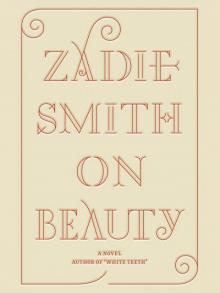 On Beauty
On Beauty Nw
Nw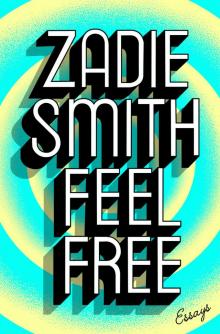 Feel Free: Essays
Feel Free: Essays The Book of Other People
The Book of Other People White Teeth
White Teeth Changing My Mind: Occasional Essays
Changing My Mind: Occasional Essays N.W.
N.W. Swing Time
Swing Time The Embassy of Cambodia
The Embassy of Cambodia The Autograph Man
The Autograph Man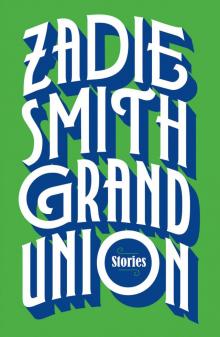 Grand Union
Grand Union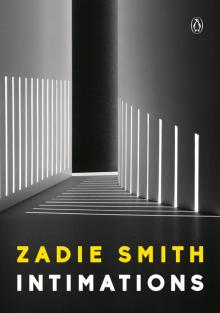 Intimations
Intimations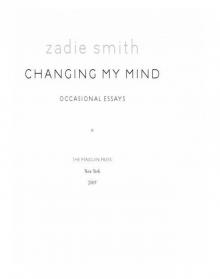 Changing My Mind
Changing My Mind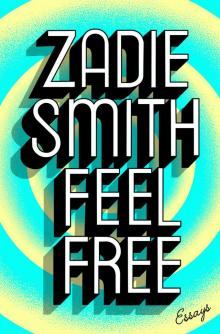 Feel Free
Feel Free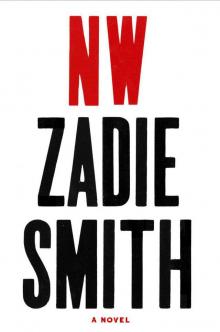 NW: A Novel
NW: A Novel